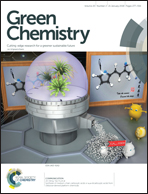Corrosion behaviour of eco-friendly airbrushed reduced graphene oxide-poly(vinyl alcohol) coatings†
Abstract
Metal pretreatments play a crucial role in the long-term performance of metals. Hexavalent chromium has been a state of the art metal pretreatment, but it is being phased out due to human health and environmental concerns. Therefore, the need for environmentally friendly pretreatment coatings has emerged. 2-D nanomaterials such as graphene have gained interest in this regard because of their ability to act as physical barriers to corrosion-causing agents, yet graphene's deposition is not always scalable or sustainable. Adding to the complexity, the corrosion inhibiting ability of 2-D graphene nanosheets has exhibited differing results in the past. Here, we present reduced graphene oxide-polyvinyl alcohol (PVA) nanocomposite coatings on branched polyethylenimine (B-PEI)-coated aluminum alloy 2024-T3, where B-PEI, acts as an adhesion promoting layer, realized by a high throughput airbrushing process of a graphene oxide-polymer ink followed by reduction. For the first time, a water-stable dispersion of reduced graphene oxide and polyvinyl alcohol (PVA) is prepared and quickly sprayed to yield a smooth pinhole-free coating, where reduced graphene oxide sheets act as bricks and PVA as mortar. It is shown that the coating is an exceptional oxygen barrier, similar in performance to SiOx. The reduced graphene oxide sheets may also provide an alternative electronic pathway that prevents electrons from reaching the cathodic site, thereby hindering the corrosion cycle. Coatings with varying compositions on aluminum alloy 2024-T3 were evaluated in 0.2 M NaCl solution for 30 days period. The alloy coated with 60 to 70 wt% reduced graphene oxide exhibited the best performance, with little to no corrosion. Coatings with higher or lower reduced graphene oxide content exhibited corrosion due to increased oxygen permeability and swelling, which may explain conflicting prior reports.



 Please wait while we load your content...
Please wait while we load your content...